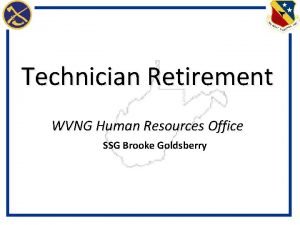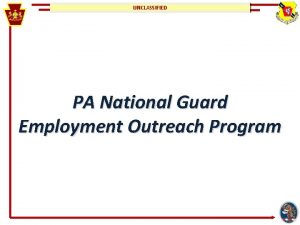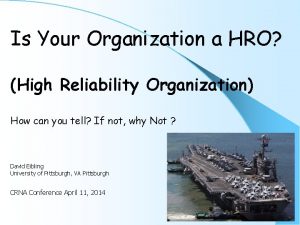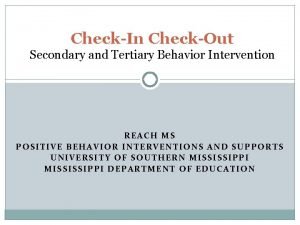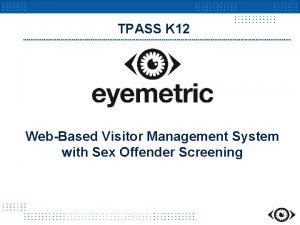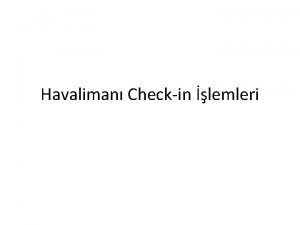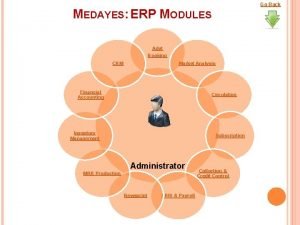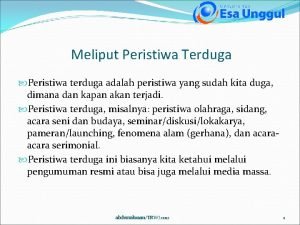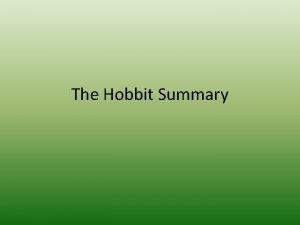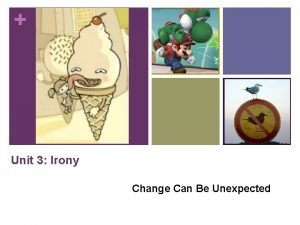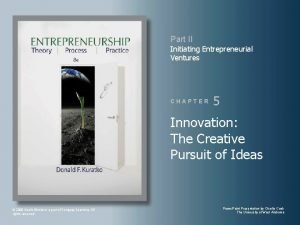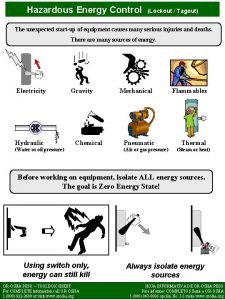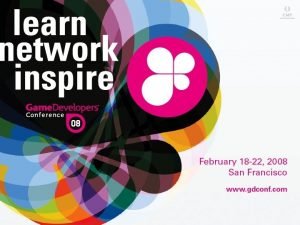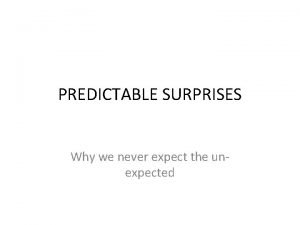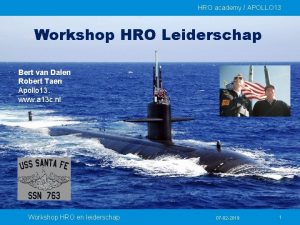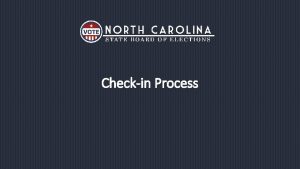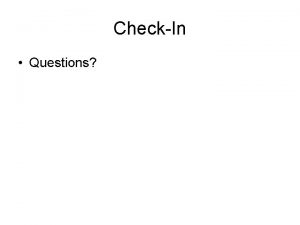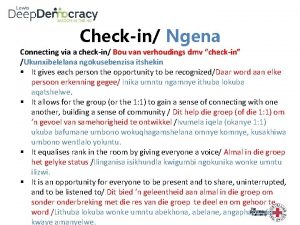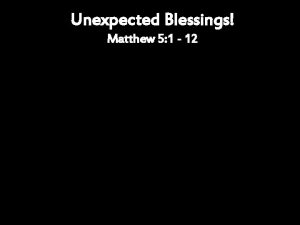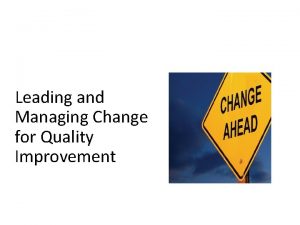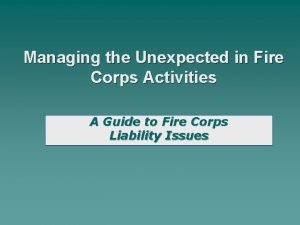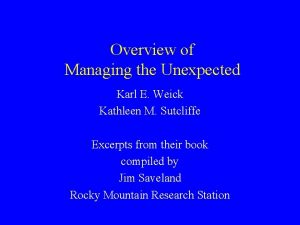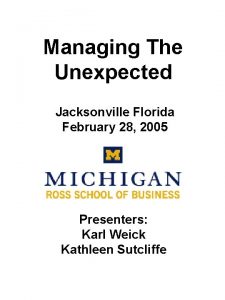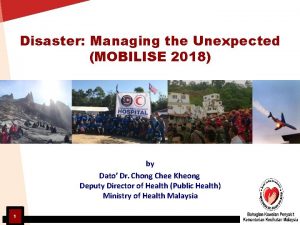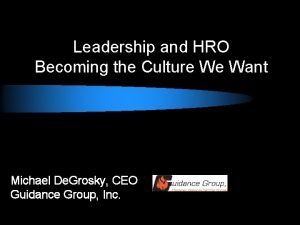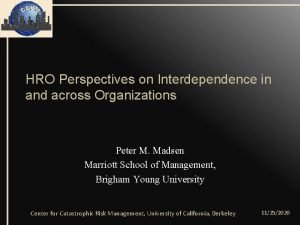DAY 3 CHECKIN AGENDA MANAGING THE UNEXPECTED HRO









































































- Slides: 73

DAY 3 CHECK-IN AGENDA: MANAGING THE UNEXPECTED, HRO, EQ • Thoughts, Reflections, Questions?

MANAGING THE UNEXPECTED HIGH PERFORMANCE IN A COMPLEX WORLD GOAL: THREE THINGS

UNEXPECTED: YES YET NOT ON YOUR WATCH Q. WHAT MIGHT BE UNEXPECTED IN THE BUSINESS WORLD?

MANAGING THE UNEXPECTED The best way for an organization -- and its people -- to respond to predictable or more importantly to unpredictable challenges is by building a Highly Reliable Organization (HRO) that expertly spots the unexpected when it crops up and then quickly adapts to meet the changing environment.

1 POINT FOR "NOT AT ALL, " 2 POINTS FOR "TO SOME EXTENT, " 3 POINTS FOR "A GREAT DEAL. " 1. There is an organization-wide sense of vulnerability to the unexpected. 2. Everyone feels accountable for reliability. 3. Leaders pay as much attention to managing unexpected events as they do to achieving formal organizational goals. 4. People at all levels of our organization value quality. 5. We have spent time identifying how our activities could potentially harm our organization, employees, customers, other interested parties, and the environment at large. 6. We pay attention to when and why our employees, customers, or other interested parties might feel peeved at or disenfranchised by the organization. 7. There is widespread agreement among the firm's members on what shouldn't go wrong. 8. There is widespread agreement among the firm's members on what could go wrong.

HROS EXHIBIT "MINDFULNESS. " • Mindfulness indicates a combination of high alertness, flexibility, and adaptability. • A total score higher than 16 indicates an exemplarily mindful infrastructure in your organization (that’s great – listen up and share your best practices). • A score lower than 10 suggests a need for immediate improvement (time to really pay attention).

ARTICLE DISCUSSIONS • Karl Weick • Sensemaking • 5 Habits of a HRO

MANN GULCH DISASTER


LLL Walter Rumsey and Robert Sallee Robert Wagner Dodge • Speed relating • Share yours; Listen for theirs • Whole class discussion – you highlight what you have learned from others!

THE LEADERSHIP MOMENT BY MICHAEL USEEM As amazing as Wag Dodge's innovation was, the life-saving concept did not achieve its intended purpose. Why didn't Dodge's well-trained team heed his instructions? • Some argue that in the jump crew's eyes Dodge had lost credibility during their two hours on the ground. • For starters, Dodge had left his post at the front of the group early in the fire fight; • Later, when he instructed the team to drop their equipment, he failed to realize that he was asking them to give up a significant part of what defined them as a fire jump crew: their uniform; • Ultimately, some argue that Dodge's historically soft spoken leadership, his desire to lead by example, impeded the group's ability to understand their leader's thought process and realize what he was intending when he lit his innovative and life-saving escape fire. The Wag Dodge Mann Gulch incident not only illustrates the relationship between panic and performance (the idea that the crew, as they neared Dodge's escape fire, were too panicked to process new information correctly), but also demonstrates the importance of recognizing leadership as a dynamic interaction, one that is sensitive (with the potential to deteriorate) to a changing environment.

AFTERMATH • 450 men fought for five more days to get the fire, which had spread to 18 km 2 (4500 acres), under control. • Wagner Dodge survived unharmed and died five years later of Hodgkin's disease. • Thirteen crosses were erected to mark the locations where thirteen firefighters who died fighting the Mann Gulch Fire fell. However, one of the smokejumpers who died in the Mann Gulch Fire was David Navon, who was Jewish. In 2011 the cross marking the location where Navon died was replaced with a marker bearing a Star of David[2] • Several months following the fire, fire scientist Harry Gisborne, from the US Forest Service Research Center at Priest River, came to examine the damage. Having a history of heart problems, he nevertheless conducted an on-ground survey of the fire site. He suffered a heart attack and died while finishing the day’s research. • Gisborne had forwarded theories as to the cause of the blowup prior to his arrival on site. Once there, he discovered several conditions, which caused him to change his concepts of fire activity particularly those pertaining to fire "blow-ups". He noted this to his companion just before his death on 9 November 1949. • There was some controversy about the fire, with a few parents of the men trying to sue the government. One charge was that the 'escape fire' had actually burned the men. • Lessons learned from the Mann Gulch fire had a great impact on firefighter training. However, some of the lessons were forgotten and the tragedy would be repeated in the South Canyon Fire of 1994, in which 14 firefighters died.

CRISIS LEADERSHIP Leadership in a (Permanent) Crisis by Ronald Heifetz, Alexander Grashow, and Marty Linsky, HBR, 2009 • Crisis leadership has two distinct phases. • Emergency phase, when your task is to stabilize the situation and buy time. • Adaptive phase, when you tackle the underlying causes of the crisis and build the capacity to thrive in a new reality.

CRISIS LEADERSHIP: EMERGENCY PHASE 1. Figure out what is going on – take time to understand what’s happening 2. Remember that speed counts – attack it as quickly as possible 3. Remember that slow counts too – know when to back off and wait for a better opportunity 4. Respect the danger of the unfamiliar – vu jade 5. Value the skeptic – listen to the black hat (self/others) 6. Be ready to ‘fight fire with fire’ Schermerhorn & Wright (2018)

CRISIS LEADERSHIP: ADAPTIVE PHASE • Develop next practices (beyond today’s best practices) • Distinguish the essential from expendable (run experiments) • Embrace Disequilibrium – orchestrate (depersonalized) conflict, chaos and confusion (courageous conversations) to allow people to see this as productive • Distributive Leadership – mobilize everyone for solutions Leadership in a (Permanent) Crisis by Ronald Heifetz, Alexander Grashow, and Marty Linsky, HBR, 2009

ARTICLE DISCUSSIONS • Karl Weick • Sensemaking • 5 Habits of a HRO

AVOIDING THE CRISES … MINDFULNESS AND HRO 1. Aren’t tricked by success 2. Defer to experts – on the front line 3. Let unexpected circumstances provide your solution 4. Embrace complexity 5. Anticipate – but anticipate your limits

5 MINDFUL HABITS OF HRO 1. Don't be tricked by your success. Don't gloat over successes. In fact, it's just the opposite – HROs are preoccupied with their failures. If you have a gut feeling that something isn't right – pay attention, something is likely wrong. Listen to other people’s gut feelings (experience) Q – how often do you pick up on small downward deviations.

5 MINDFUL HABITS OF HRO 2. Defer to your Experts on the Front Line. People at the top may think that they have the big picture. More accurately, we have a picture, certainly not the picture, and certainly not bigger in the sense that it includes more data. The picture that frontline workers see is different. It is drawn from their firsthand knowledge of the organization's operations, strengths, and weaknesses. Q - How often do you let your supervisor know when something ‘different’ happens?

5 MINDFUL HABITS OF HRO 3. Let the unexpected circumstances provide your solution. When something out of the ordinary happens, your stress level rises. What will happen is that your perception will narrow -- you will get tunnel vision -- and you will miss a lot of stuff. Resist that dramatic narrowing of cues -- because within everything that is happening unexpectedly, you will find what you need for a remedy. (Fight fire with fire: Dodge) Q. How often do you actually take time to reflect?

5 MINDFUL HABITS OF HRO 4. Embrace complexity. In the face of all of this complexity, HROs are reluctant to accept simplification; understand that it takes complexity to sense complexity. Insight and understanding develops when people attend to more things, entertain a greater variety of interpretations, differentiate their ideas, argue, listen to one another, work to reconcile differences, and commit to revisiting and updating. Q. – How often do you get together to argue, listen, and understand?

5 MINDFUL HABITS OF HRO 5. Anticipate -- but also anticipate your limits. We can't anticipate everything. There's such a premium on planning, on budgeting, on making the numbers. In the face of all that, the notion of resilience has an affirming quality: You don't have to get it all right in advance. That doesn't mean you should stop anticipating. But you should add in two subtleties. First, focus your attention on key mistakes that you do not want to make (never events). Second, trust your anticipations, but be wary of their accuracy. You can't see the whole context that is developing. Q. How do you work on building capacity for resilience?

MINDFULNESS IS ABOUT CONNECTING To make sense is to connect the abstract with the concrete. And, do this wisely involve a community of sensemakers.

ONE POINT TO MANY … 3, 456, 000

MINDFULNESS IS ABOUT ACTION If the first question of mindfulness is “what’s going on here? , ” (The Picture) The second, equally important question is “what do I do next? ” (Action)

“When it comes to the future, there are three kinds of people: those who let it happen, those who make it happen, and those who wonder what happened. ” John M. Richardson Jr.

SUMMARY 1. Mindful of Failure: Focus upon small differences (trust your gut feelings / experience) 2. Defer to Experts: Listen to the troops – they know the terrain best – and let them lead 3. Be Resilient: Be flexible and always look for new answers or ways (keep getting better) 4. Embrace Complexity: Hold big tent meetings – and create conversations 5. Anticipate and be Ready: Look ahead but be prepared and willing to act quickly (organizational slack) Mindfulness Tools: policy and planning (not the plan), training (alertness, flexibility, and adaptability), communicate, communicate

THE “SO WHAT” MOMENT • Who are you now? • What are you going to continue to do? • What are you going to do differently? • And the Magic Number is …

TEAM TIME

EQ AND YOU

EMOTIONS AT WORK • Jan comes in to her office and throws her papers on her desk. • Claude comes in with coffee for both. • “Could you just fix the messed up Jackson file and have it on my desk by noon. ” • Claude walks out with a three letter look.

EMOTIONS AT WORK (BACKSTORY) Bad mood rising – Jan’s morning • Son failed exam – disappointment • Anger for not having paid attention • Anger for arguing with partner • Anger at driver who cut her off • Anger when walking in – reception area is messy Jan: Not recognizing these emotions in self. Claude: Not understanding how to deal with emotional signals. Result: Awkward moment and resulting poor productivity from Jan (and Claude). • PS Ever experienced something like this?

OUTCOMES FOR THIS AFTERNOON • Self-Leadership: Awareness of self • Communication: Sending clear and convincing messages. • Political and Emotional Awareness: Reading individual and group’s emotional currents and power relationships. Negotiating and resolving disagreements. • Leading Change: Inspiring and guiding groups and people.

PARTNER-UP

WHAT FEELING DOES THIS PHOTO ILLICIT? DISCUSS

WHAT FEELING DOES THIS PHOTO ILLICIT? DISCUSS

WHAT FEELING DOES THIS PHOTO ILLICIT? DISCUSS

WHAT FEELING DOES THIS PHOTO ILLICIT? DISCUSS

INDIVIDUALLY LIST … • A variety of shades of White • A host of different Emotions

LIST … A variety of shades of White: A host of different Emotions: • White, really white • Happy, Mad • Beige, creamy, ivory, • Agitated, alarmed, lace, melon tint, amused, angry, paper-white, annoyed, anxious, welcome-white, awed, bitter, bored, dover-white, purebewildered, calm, white, extra-white, cautious, comfortable, ecru, nonchalant confused, constrained

EMOTIONAL INTELLIGENCE (EQ) Model theoretically developed and empirically tested now it has also been popularized • Focus: Understanding self: your intentions, responses, behaviour and feelings. Understanding others: and their feelings.

EQ BUSINESS CASE (WHY IMPORTANT) 1. Experienced partners in a multinational consulting firm were assessed on the EI competencies plus three others. Partners who scored above the median on 9 or more of the 20 competencies delivered $1. 2 million more profit from their accounts than did other partners – a 139 percent incremental gain (Boyatzis, 1999). 2. In complex jobs, a top EI performer is 127 percent more productive than an average performer (Hunter, Schmidt, & Judiesch, 1990). 3. After supervisors in a manufacturing plant received training in emotional competencies such as how to listen better and help employees resolve problems on their own, lost-time accidents were reduced by 50 percent, formal grievances were reduced from an average of 15 per year to 3 per year, and the plant exceeded productivity goals by $250, 000 (Pesuric & Byham, 1996).

NOW AS A PICTURE …

NOW AS IN WHAT DOES THAT MEAN FOR YOU …

WHO ARE YOU NOW? • Please take out your phone … • https: //globalleadershipfoundation. com/geit/eitest. html

EMOTIONAL INTELLIGENCE: THE 4 BRANCH MODEL Branch Name Brief Description of Skills Involved 1. Perceiving Emotion (Self-Awareness) Ability to identify emotions in oneself and others (as well as in objects, art, stories, music, other stimuli) 2. Understanding Emotion (Social Awareness) Ability to comprehend emotional information, how emotions combine and progress through relationship transitions and to appreciate emotional meaning 3. Managing Emotion (Self-Management) Ability to be aware of own feelings, to regulate them in oneself and help others to do this as well to promote personal understanding and growth 4. Using Emotion to Facilitate Action (Relationship Management) Ability to generate, use and feel emotion as necessary to communicate feelings, or use them in other cognitive processes


PARTNER-UP (NEW PARTNER)

1. EXERCISES FOR SELF-AWARENESS • Reflect on your four scores – surprises? Discuss • Reflect on how you feel right now? Discuss • Visit your values – what do you stand for (stand against) – pick 3! Discuss Homework: Make a list of your daily emotions list on the left by the hour / list on the right the context that surrounded them • Outcome: Awareness of how you are feeling. Reflect on why you do the things that you do?


2. ALL TALK AND NO FEELINGS … PERCEIVING EMOTIONS (OTHERS) Determine what Emotions are Being displayed

2. ALL TALK AND WITH FEELINGS

2. UNDERSTANDING EMOTION • Sensing others’ feelings and perspective, and taking an active interest in their concerns. • Attentive to emotional cues and listen well. • What are the emotional clues we / you attend to?

2. EMOTIONAL CLUES • Eyes, mouth, speed, voice, tone, posture • Culture : ) : ( (^_^) (; _; ) Commercial: Looking for a mate who in everyday conversation can pick up even your most subtle emotional cues? A. Find a musician.

2. TIME FOR SOME EMOTIONAL EXERCISES • Small group discussion Should Management receive bonuses based upon short-term company performance? • Individually, stop by and pick up a note from me prior to starting your exercise.

DEBRIEF • Did we recognize the emotions in others? • And the academy award goes to …

BODY LANGUAGE

2. EXERCISES FOR SOCIAL AWARENESS • Live in the Moment: In whatever situation, just be present, don't think about the past or the future, fully experience what is happening now. • Tour around for 10 minutes: observe the behaviour around you

3. MANAGE YOUR EMOTIONS • Sticky Hot • Get on, More squeeze in • Poke in the back • Twice • Thrice • Anger builds • Turn to face

3. MANAGE YOUR EMOTIONS • Become emotionally literate. Label your feelings, rather than labeling people or situations. “I feel impatient” vs “This is ridiculous. ” • Use your feelings to help make decisions. “How will I feel if I do this? ” “How will I feel if I don’t? ” • Examine how you react to stressful situations. Take more responsibility for your feelings. “I feel angry” vs “You are making me angry. ” • Find a way to stay calm.

3. EQ: SELF-CONTROL • Be Aware • Stay composed, positive, and unflappable even in trying moments • Helicopter effect – rise above • Breathe

RELAXATION EXERCISE

4. RELATIONSHIP MANAGEMENT • Impressions carry the day – be excited; message is secondary (emotion > facts) • Consumers buy on emotion • What are our strongest emotions? • Hope, fear, joy, sadness • Task: Create an emotional argument to get your neighbour to do something.

EMOTIONAL WORDS Alarmed, angry, apprehensive, awkward Bitter, bored, cheerful, curious, cynical Delighted, discouraged, eager, enraged, excited Frustrated, fatigued, grouchy, happy, hopeful, Irked, intense, joyous, jealous, loving, lonely Mad, miserable, numb, nice, overwhelmed Pleased, proud, puzzled, queasy, rejected, sad Safe, scared, shy, shocked, sorry, surprised Troubled, upset, victorious, excited, yucky, zany

EXERCISES FOR RELATIONSHIP MANAGEMENT • Remember the little things: please, thankyou, I’m sorry, say names. • When you care, show it: small gestures to express your feelings and gratitude. • Explain your decisions, don't just make them: explain why.

TOUGH CONVERSATION • Anyone have one lately? • Partner up

TASK: TACKLE TOUGH CONVERSATIONS 1. First, start with an agreement - what's the shared ground? 2. Then ask the person to share their side or point of view. Resist speaking up, listen fully to understand the other person, don't go on the defensive right away. 3. Now help the other person understand your side - describe discomfort, thoughts, ideas, reasons etc. 4. Move the conversation forward by finding common ground again based on what you've learned about each other's views. 5. Keep in touch after this conversation and check in on progress made that you agreed upon together.

SKILL DEVELOPMENT OPPORTUNITY • Pat calls Chris into his/her office to discuss a challenge – Chris has not been performing well lately. His/her performance has dropped off. Pat is confident that Chris can do better. • Chris feels that Pat is unappreciative of the substantial progress s/he has made. • Before assuming the roles imagine how you would feel in such a circumstance - plan your thoughts and then play the role.

EQ TAKEAWAY LESSONS 1. Rather than seeing jobs as purely rational undertakings, you need to assess the ‘emotional impact’ of each employee's job, and to design job assignments that take this into account. 2. Organizations are not cold places that people enter just to work. Managers need to create a positive and friendly emotional climate, and to model this through their own behavior.

3. Selection of employees and teams needs to be based, in part, on a positive emotional attitude. Managers should select employees on the basis of their record for engendering a positive emotional attitude in their work teams. 4. Managers should seek to train their employees to improve their emotional intelligence skills and to engage in healthy emotional expression at work.

What are your Three?

REFLECTION TIME

TEAM TIME … HAVE A GREAT REST OF THE DAY!
 Day 1 day 2 day 3 day 4
Day 1 day 2 day 3 day 4 Day 1 day 2 day 817
Day 1 day 2 day 817 Hawaii national guard hro
Hawaii national guard hro Reluctance to simplify hro
Reluctance to simplify hro Wvng hro
Wvng hro High reliability components
High reliability components Afi 36-3003
Afi 36-3003 Confluence hro
Confluence hro Pa national guard hro
Pa national guard hro A hro
A hro Agenda sistemica y agenda institucional
Agenda sistemica y agenda institucional Check in checkout
Check in checkout K12 visitor management
K12 visitor management Tu graz check in
Tu graz check in Checkin uci
Checkin uci Pegasus check in
Pegasus check in Archive.ics.uci
Archive.ics.uci Bookit
Bookit Expect the unexpected
Expect the unexpected Berita terduga adalah
Berita terduga adalah Taste roald dahl
Taste roald dahl Hobbit chapter 16 summary
Hobbit chapter 16 summary Unexpected kernel mode trap
Unexpected kernel mode trap Expected and unexpected behaviors
Expected and unexpected behaviors Lamb to the slaughter idiom
Lamb to the slaughter idiom Innovation and invention
Innovation and invention Unexpected startup
Unexpected startup An unexpected directx error occurred present failed
An unexpected directx error occurred present failed The hobbit chapter 1
The hobbit chapter 1 Unexpected challenges 1995
Unexpected challenges 1995 Never expect the unexpected
Never expect the unexpected Seed germination inhibitors examples
Seed germination inhibitors examples Family sis schoolmax
Family sis schoolmax Casting crowns dying he saved me
Casting crowns dying he saved me Tomorrow i dont know
Tomorrow i dont know Day by day seed germination observation chart
Day by day seed germination observation chart Oceans apart day after day meaning
Oceans apart day after day meaning Day one day one noodle ss2
Day one day one noodle ss2 Key points of romeo and juliet
Key points of romeo and juliet Role of transpiration
Role of transpiration Day to day maintenance
Day to day maintenance Day one day one ss2
Day one day one ss2 Growing day by day
Growing day by day I live for jesus day after day
I live for jesus day after day As your room gets messier day by day, entropy is
As your room gets messier day by day, entropy is Lời thề hippocrates
Lời thề hippocrates Vẽ hình chiếu đứng bằng cạnh của vật thể
Vẽ hình chiếu đứng bằng cạnh của vật thể độ dài liên kết
độ dài liên kết Quá trình desamine hóa có thể tạo ra
Quá trình desamine hóa có thể tạo ra Kể tên các môn thể thao
Kể tên các môn thể thao Hình ảnh bộ gõ cơ thể búng tay
Hình ảnh bộ gõ cơ thể búng tay Sự nuôi và dạy con của hươu
Sự nuôi và dạy con của hươu Dot
Dot điện thế nghỉ
điện thế nghỉ Biện pháp chống mỏi cơ
Biện pháp chống mỏi cơ Trời xanh đây là của chúng ta thể thơ
Trời xanh đây là của chúng ta thể thơ Chó sói
Chó sói Thiếu nhi thế giới liên hoan
Thiếu nhi thế giới liên hoan Phối cảnh
Phối cảnh Một số thể thơ truyền thống
Một số thể thơ truyền thống Thế nào là hệ số cao nhất
Thế nào là hệ số cao nhất Ng-html
Ng-html Hệ hô hấp
Hệ hô hấp Tư thế ngồi viết
Tư thế ngồi viết Số nguyên tố là gì
Số nguyên tố là gì đặc điểm cơ thể của người tối cổ
đặc điểm cơ thể của người tối cổ Các châu lục và đại dương trên thế giới
Các châu lục và đại dương trên thế giới Mật thư tọa độ 5x5
Mật thư tọa độ 5x5 Thang điểm glasgow
Thang điểm glasgow ưu thế lai là gì
ưu thế lai là gì Thẻ vin
Thẻ vin Cái miệng xinh xinh thế chỉ nói điều hay thôi
Cái miệng xinh xinh thế chỉ nói điều hay thôi Các châu lục và đại dương trên thế giới
Các châu lục và đại dương trên thế giới Bổ thể
Bổ thể




